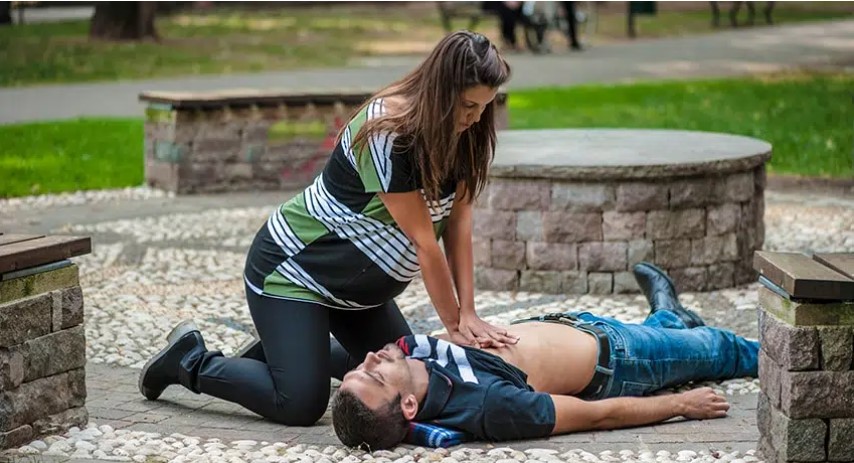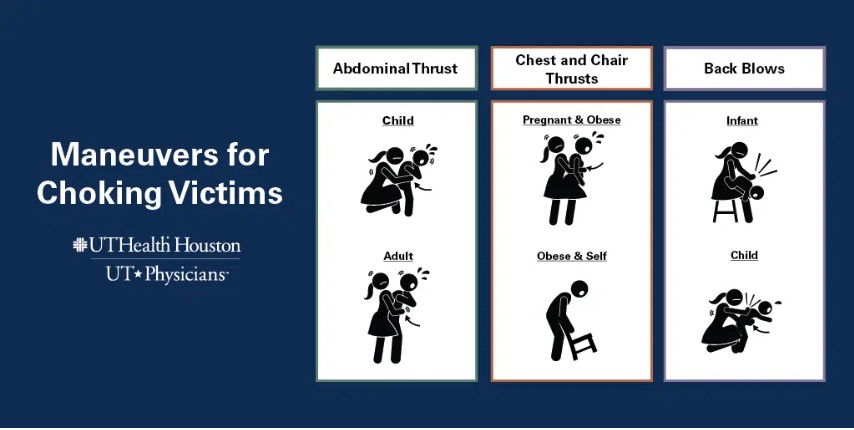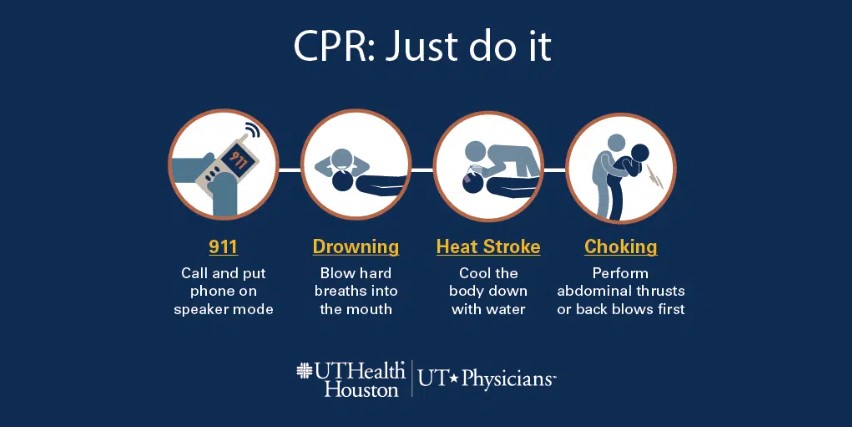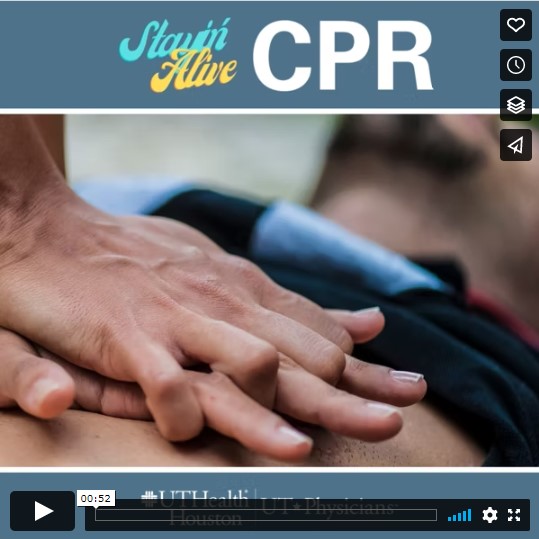Dr. Hilary Fairbrother on CPR, Choking and Drowning Response Strategies

Should you witness someone collapse and not breathing, call 911, and get ready to perform CPR. (Photo: Getty Images)
Summer is the peak time for outdoor activities, but it is also the peak time for accidents that can literally take a person’s breath away. To be a lifesaver to a loved one or stranger, learn CPR.
 “You don’t need formal training to perform CPR, and doing it can double someone’s chance of survival,” said Hilary E. Fairbrother, MD, associate professor of emergency medicine with McGovern Medical School at UTHealth Houston.
“You don’t need formal training to perform CPR, and doing it can double someone’s chance of survival,” said Hilary E. Fairbrother, MD, associate professor of emergency medicine with McGovern Medical School at UTHealth Houston.
Above all, do not be afraid to perform CPR. Attempting the lifesaving procedure is better than doing nothing at all.
“Bystanders are usually afraid they’ll do something wrong, so they don’t do anything. Call 911, and just do it,” Fairbrother said. “Any possible damage from vigorous CPR is fixable. The damage from lack of blood flow to the brain can’t be fixed. Without CPR, the victim will die or be left with severe brain damage. Those are things no doctor can fix.”
This summer, learn basic CPR from an emergency medicine specialist and the key points to remember in situations of drowning, heat stroke, and choking.
Hands-only CPR: Press fast and hard on the chest
Whenever anyone collapses, call 911, and prepare to begin CPR. Consider this the golden rule.
“If the person appears lifeless or is not breathing, call 911 and put the phone on speaker mode. This will free up your hands as the operator guides you,” Fairbrother said. “Then kneel beside them with your knees toward the chest area, put your phone down, and get ready to perform CPR.”
Before beginning, make sure the patient is on their back on a flat surface. Gently shake them and ask some questions. Check for breathing: Is the chest rising and falling? Can you hear any breaths? Can you feel any breaths on your cheek? If they are unresponsive and not breathing, begin hands-only CPR.
To start CPR, put one hand over the other and intertwine your fingers; use the top hand to raise the fingers of your bottom hand. Place your hands in the middle of the person’s chest facing an east or west direction. With arms straight and elbows locked, use the palm of your hand to start pushing down fast and hard. The rate should be 100 to 120 compressions per minute.
“An easy way to keep the rate is to sing the chorus of “Stayin’ Alive” in your head,” Fairbrother said. “Keep repeating, ‘Ah, ha, ha, ha, stayin’ alive, stayin’ alive’ in your head. The song is the perfect tempo for CPR.”Continue compressions until emergency medical services (EMS) workers can take over.
Should the patient recover quickly on their own or after CPR, do not let them leave alone.
“If someone collapses or suffers anything life-threatening, they really should be taken to a hospital and checked for bodily damage and the underlying cause. If they refuse to go to a hospital, they should at least go home with a friend or relative,” Fairbrother said.
Drowning: Blow hard breaths into the mouth
Whenever anyone drowns, it is vital to perform rescue breaths in addition to compressions.
For rescue breaths, place the palm of your hand on the person’s forehead and tilt the head back approximately 45 degrees to open the airway. Pinch the nose with one hand and place your other hand under the chin to help lift it. Seal your lips over the victim’s entire mouth. Blow two hard breaths into the person’s mouth and follow with 30 compressions. Repeat the breaths and compressions until paramedics can offer relief.
Should CPR induce water spit up or vomiting, roll the individual on to their side. If normal breathing does not resume, clear and clean the patient’s mouth and continue rescue breaths and compressions.
For very young children, adjust this procedure. Tilt the head back slightly for toddlers (ages 3 and under); keep the head neutral for infants. Then give two gentle breaths and 15 fast compressions.
“With small kids and drowning, rescue breaths are even more important. This is why I recommend increasing the frequency with two breaths every 15 seconds,” Fairbrother said.
Heat stroke: Cool the body down with water
Whenever anyone suffers a heat stroke, it is necessary to cool down a person’s high body temperature with water.
“If the person collapses but is still conscious and breathing, pour water over their head and give them room temperature water to drink. Don’t give ice water because it may cause cramps. Gatorade and sugary drinks aren’t helpful, either. Water is best,” Fairbrother said.
Remove as much clothing as possible from the heat stroke victim as well as any sports equipment. If possible, move them into a cooler climate, such as an air-conditioned building or even a shady tree. Also, raise the legs of the patient as they lie flat on their back.
If the heat stroke victim is not responsive and does not appear to be breathing, begin hands-only CPR. Continue until medical workers can deliver aid.
“For heat stroke, the best thing to do is to prevent it. Drink plenty of water and stay hydrated before going out into the hot sun. Carry water with you, and avoid strenuous activities during the hottest hours of the day,” Fairbrother said. “Heat stroke can also happen indoors. If your home isn’t air conditioned and the windows don’t open easily, purchase fans to help.”
Choking: Perform abdominal thrusts first
Whenever anyone is choking, try to dislodge the obstruction in the airway before applying CPR. Apply abdominal thrusts (Heimlich maneuver) first to someone in distress.
To do this, stand behind the person and place your arms around their waist. Make a fist with one hand, with the tucked thumb toward the stomach; place your other hand over the fist. Just above the navel, press hard into the stomach and repeat. Use quick, upward thrusts, as if trying to lift the patient. Continue until the food/object comes out or the EMS team arrives.
Modify this method for larger people, and use a different technique for young children. With a pregnant woman, put your arms underneath her arms and place your hands on the base of the breastbone to begin chest thrusts. With a heavy individual, perform chest compressions or move in front of them and thrust their abdomen with the back of a chair. With a small child, kneel behind them to give abdominal thrusts or back blows.
For back blows, bend the child over keeping one arm across the chest. With your free hand, hit the back hard between the shoulder blades. For an infant, place them down on the thigh or forearm before giving a blow.

Maneuvers for choking victims: Abdominal thrusts for children and adults. Chest thrusts for pregnant and obese people. Chair thrusts for obese people and on self. Back blows for infants and young children.
“With choking victims, also try to check the mouth. If you see something in the mouth, use a single finger to remove it,” Fairbrother said. “If you don’t see anything, don’t do a ‘blind’ sweep because you might push it back further.”
If the person has already collapsed and lost consciousness, begin hands-only CPR.
“CPR is normally not administered until a person stops breathing, but the procedure may also help dislodge what is in the airway,” Fairbrother said. “Do the CPR, and stay on the phone with the 911 operator until the medics show up.”
According to Fairbrother, people of all professions are capable of saving lives.“The 911 operators are trained to help ordinary people in emergency situations. Remember to call 911 first so they can help you perform CPR,” Fairbrother said. “If don’t have your cell phone, just try your best to give the patient chest compressions. Someone might come to help you. Just do it. You might just save a life.”

CPR: Just do it 911: Call and put phone on speaker mode. Drowning: Blow hard breaths into the mouth. Heat Stroke: Cool the body down with water. Choking: Perform abdominal thrusts or back blows first.
Effective CPR training and easy accessibility to preventative measures are critical in the fight to save lives. The Texas-CARES Program uses the Cardiac Arrest Registry to Enhance Survival (CARES) measures and reports important cardiac arrest epidemiology, treatment parameters, and outcomes. An additional resource open to the public, Texas-CARES helps produce measurable improvements in survival of cardiac arrest patients by working with communities and health care providers to implement evidence-based practices, such as those found in the CPR LifeLinks national initiative. The program’s goal is to strengthen the chain of survival and save lives. For more information please visit TX-Cares.com.
